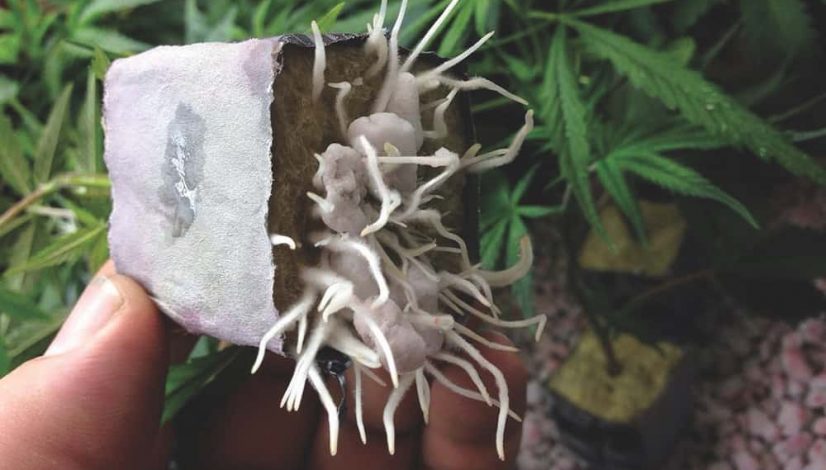Frequently Asked Questions About Cloning Cannabis
Healthy rooted cuttings provide many benefits, including the ability to grow the same strain repeatedly and the ease of maintaining a level canopy. Raise your cloning confidence by learning the tips and tricks that increase propagation rates.
When is the right time to take a clone?
The right time to take a clone is when the plant is at least five weeks old from seeding and is growing multiple side branches and shoots. You will know by handling the plant shoots if they’re older woody branches or soft tissue. Either of these can be cloned as long as you know what you are doing. The worst thing you can do is take a fresh shoot with inner walls that are still hollow—this usually ends up with the cutting wilting and becoming a soggy mess within minutes.
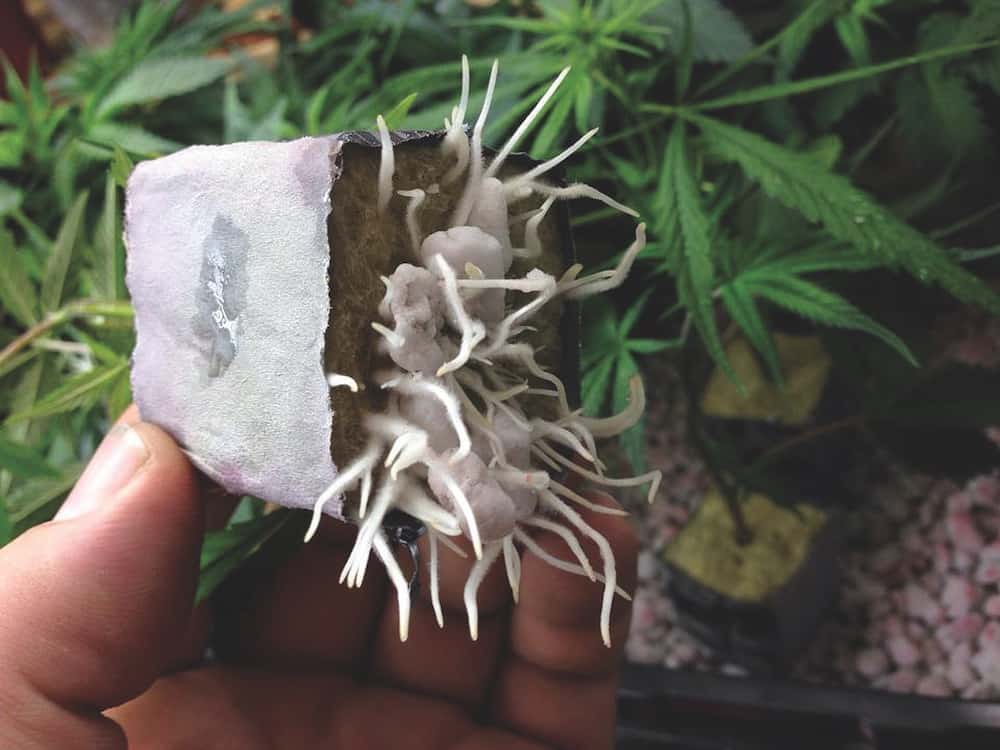
Roots protrude from a rockwool cube that’s ready to plant into a medium; Danny Danko/ High Times
Do I need to use rooting hormone?
No, you do not need to use rooting hormone, as the plants naturally create growth hormones that encourage them to produce root cells and cease the growth of stem cells and leaves. You can always give your clone a supplemental hormone, which is often IAA (indole-3-acetic acid), the most naturally occurring plant hormone of the auxin variety. Some seaweed extracts also contain natural growth hormones that stimulate root-cell development.
What is the best medium in which to root my clones?
You can buy a range of different rooting cubes and jiffy plugs these days. The smaller cube-size versions allow roots to become air-pruned as they grow out of the medium and begin their expansion. Using coco or peat-moss jiffy plugs, Root Riot foam cubes or rockwool cubes will allow you to root successfully while maintaining the proper moisture level. My personal favorite for rooting clones are 2-inch-square coco jiffy cubes.
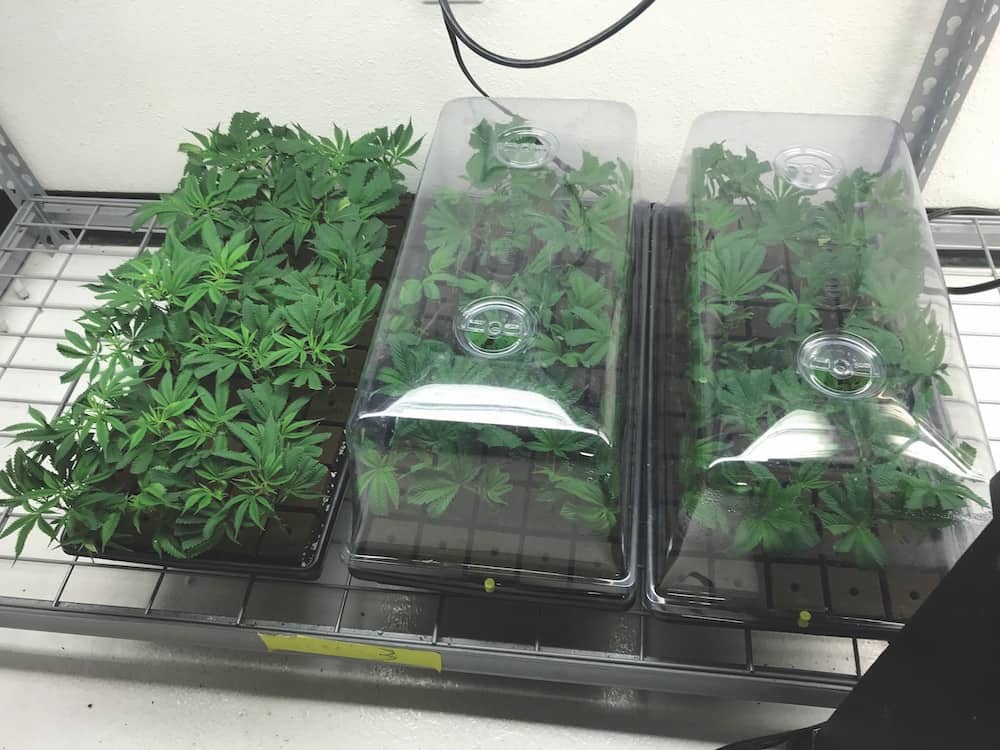
Clear domes increase humidity and rooting rates; Danny Danko/ High Times
What temperature is best for my clones?
The temperature and humidity of your cloning area needs to be warm and wet. This is the main reason why growers experience stunted clones or rooting that can take anywhere from 21 to 35 days. If your growroom temperature is below 68°F, your clones will avoid rooting. Maintain a humidity level of 70% and a temperature of 75°F.
Why is there is fuzzy mold growing inside the propagator?
If you’ve left your humidity dome for several days untouched, you may notice that stagnant air and wet conditions have caused your clones to grow a furry white fungus. When you touch the plant material, it will feel soggy or mushy. This is a major setback, especially if you are depending on growing out a certain number of plants. To remediate this, remove the lid, immediately dispose of the infected clones and introduce fresh air into the propagator. You should lift the lid for 30 seconds daily to encourage the exchange of fresh air, taking care to maintain proper temperature and humidity. Cutting a quarter-size hole into the clear plastic at either end of the lid can help circulate air as well.
How big does my propagator need to be?
From my experience, the bigger the propagator, the better it is for the clones. You can easily root cones in cups and cover them with cling-wrap film and an elastic band if you must; however, using a propagator that is 12 inches tall provides plenty of room to take larger, more mature clones. Avoid using a small propagator that is 6 inches tall or less, as you’ll only end up with cramped clones touching the wet sides and roof of the plastic dome.
Why does my clone have white bumps around its base?
This is the process whereby a cutting produces root cells. These first nubs are the earliest indicators that your clone is developing roots. At this stage, the clone is becoming an established, independent plant, so don’t disturb these delicate primordia. After it forms a fully developed root system with fibrous root hairs, the clone will independently photosynthesize and begin taking in nutrients and growing.
When will my clones start showing roots?
This is determined by a number of variables including temperature, humidity, lighting and the overall quality of the plant. As long as your cloning room is at a humidity level of 70% and the room temperature is 75°F, you should see the first roots emerging within 7-10 days. If you are using larger clones, they will root first due to their size and maturity.

Ensure there’s at least two or three sets of leaves on your clones; Dru West/ High Times
Does it matter which part of the mother plant a clone is taken from?
Many growers swear that clones taken from the base of a plant will root first, perhaps because they were closest to the mother plant’s roots. Other growers testify that cloning from the top using the mother plant’s newest growth will produce the fastest-rooting clones. Cloning cannabis is a game of patience, and trying to rush the process will only frustrate you further. As long as the cuttings you take have at least one internode and some leaves, you’ll have success.
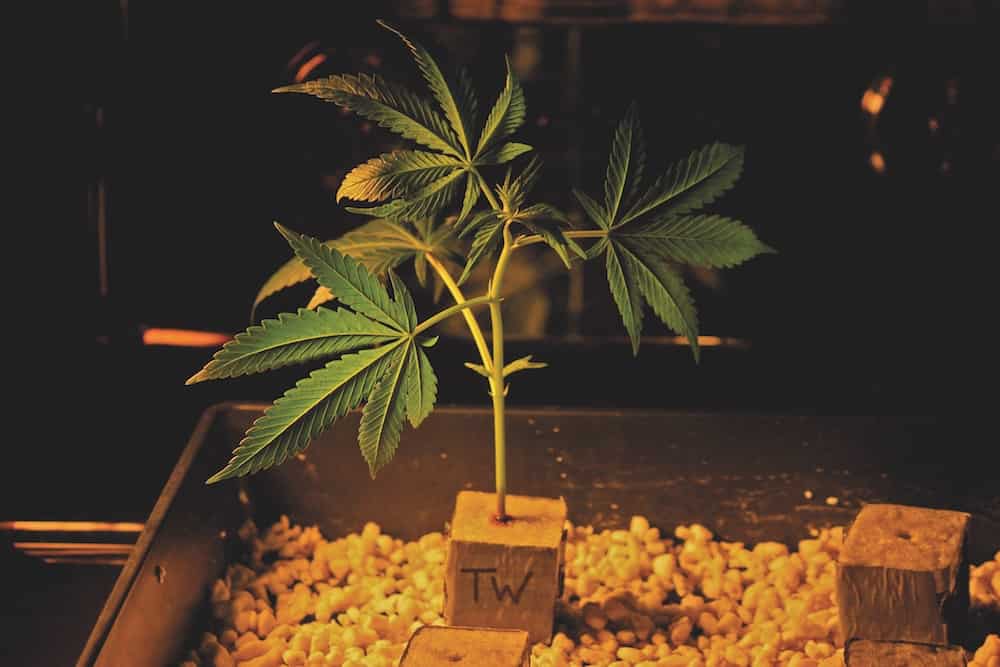
Rockwool cubes sit on top of large perlite chunks; Dru West/ High Times
Why are my rooted clones starting to wilt after taking them out of the humidity dome?
This is called the hardening-off process. Your clones have been acclimated to warm and wet conditions and now need to get used to life outside of the humidity dome. It will not take long for them to adjust, just like a fish that’s been transferred into a tank of fresh water. If your clones are wilting and look like they’re about to die, improper temperature or humidity is to blame. You must remember that you’re mimicking the spring season. Slowly introduce them into their new environment that contains intense lighting and wind from fans.
Can I transplant the rooted clones to any grow medium now?
Once your clones are hardened off and you are happy with the way they are coming along, you should prepare the grow medium into which they’ll establish themselves and grow. The roots of the clone will want to dig down as far as they can to anchor themselves firmly into the medium. Feed them very lightly at this stage and encourage more dry periods to avoid having a waterlogged medium. Roots will push out aggressively when they’re looking for moisture and available nutrients.

Clones can be aeroponically rooted in no medium at all; Dru West
Is there any other way to root clones?
If you find that the conventional technique isn’t working, you can look at other cloning methods, such as using a bubbler or air layering. Using a bubbler entails sitting freshly cut clones in a bubbling oxygenated nutrient solution with a water temperature of 75°F. Air layering is used in bonsai-tree production and can result in some large and sturdy foot-long clones when done correctly. It’s something I personally do when I want to take a large side branch and grow it as an independent clone. The amazing thing is that it’s actually performed on the plant as it’s growing normally. I strongly recommend you research this technique before attempting it, especially if you are new to plant biology.
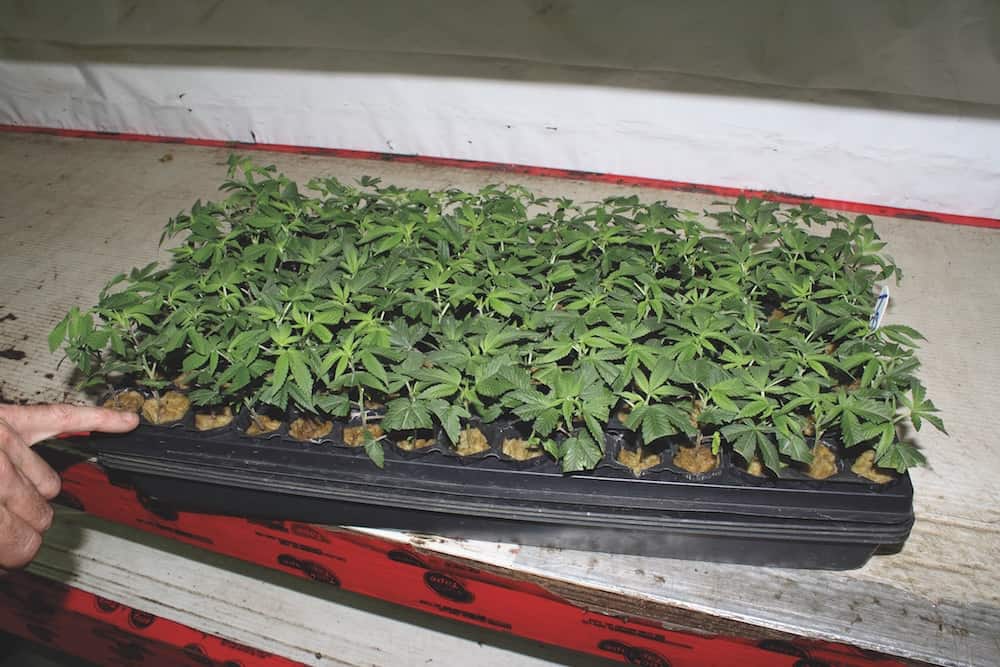
Cutting leaf blades focuses your cutting’s energy on rooting; Danny Danko/ High Times
Do I really need to cut the leaf blades down?
You do not need to remove any of the leaf blades, but it does encourage the plant to cease photosynthesis and almost shut down. This is how root cells are able to form in the dark, wet conditions of the rooting cube. Many growers simply cut a healthy clone and then, once it has rooted, allow it to grow with all its leaves intact.
It’s been 14 days and still no roots. Am I doing something wrong?
Most likely you’ve messed up one of the basics and now your pristine clones are back to square one. If you remove the clone and look at it closely, you may see that there’s no root development. In fact, there might be just a soggy decaying tip where a healthy wooden stem once sat. If this is the case, then learn from your mistake and apply root hormone, change to a fresh new medium and make sure your temperature and humidity are at the proper levels.
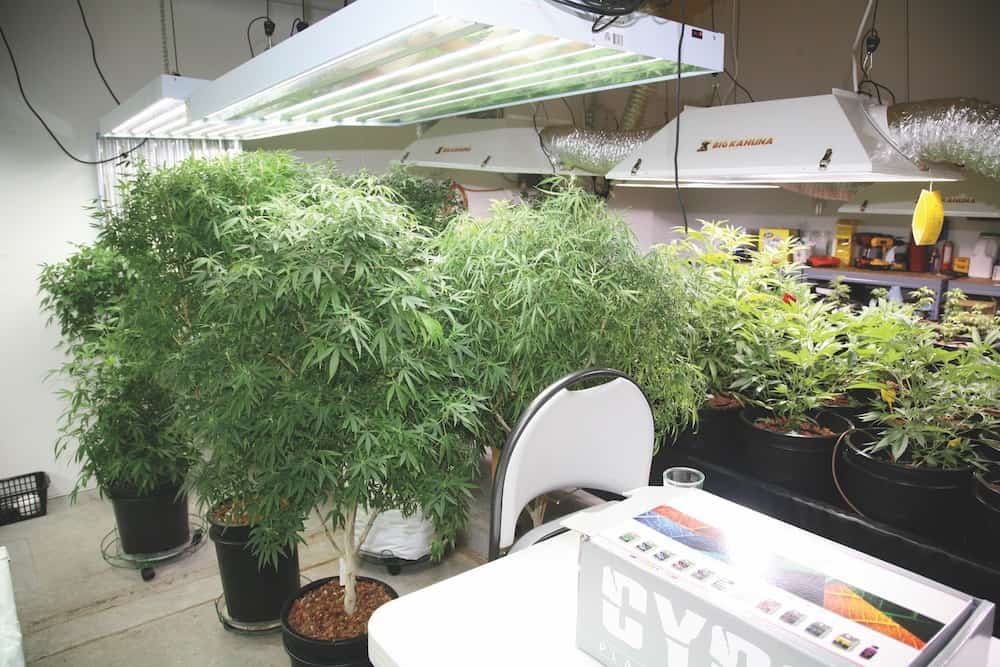
Maintaining healthy mother-plants guarantees thousands of exact replicas; Danny Danko/ High Times
How many clones can I take off a mother plant before it’s excessive?
It may be called the mother plant, but this does not mean you can butcher it. You should nurture the mother plant and raise it to produce as many healthy clones while also pruning it to fit in your space. You shouldn’t take too many clones at once, as you will eventually be left with a large woody stem with few shoots remaining. You also should consider using a new mother plant after multiple generations of cloning have taken place.
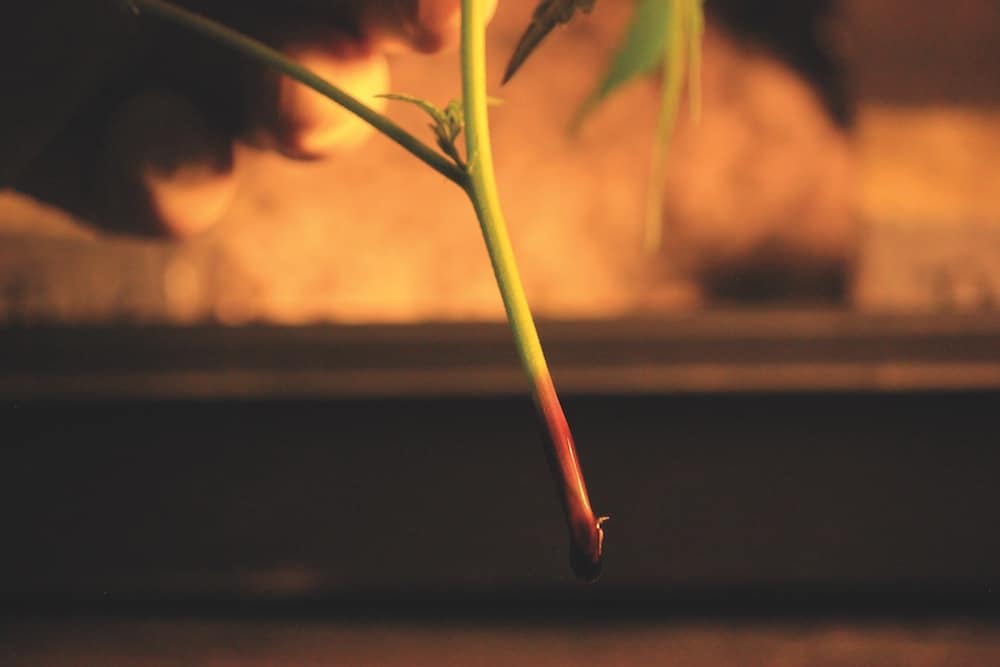
Dipping cut ends in rooting hormone protects delicate plant tissue while encouraging root production; Danny Danko/ High Times
What are the top tips for cloning?
One of my personal favorite techniques is to double dip. This involves taking a clone and wetting the bottom inch with water, then dipping the wet part of the cutting in rooting-hormone powder. Once the powder has fully stuck to the wet part, you can now dip it into a rooting gel to seal that rooting powder in and provide a double dose of natural growth hormone.
Good luck getting 100% success rates on your clones and becoming the farmer you’ve always wanted to be!
This feature was published in the July 2018 issue of High Times magazine. Subscribe right here.
The post Frequently Asked Questions About Cloning Cannabis appeared first on High Times.

